
Sons of DKR: The Dark Knight Strikes Again 01
April 8th, 2009 by david brothers | Tags: barry allen, Batman, captain marvel, dark knight strikes again, DC comics, frank miller, Sons of DKR, wonder womanThere were a few comics that hooked me when I was getting back into comics in 2003. Warren Ellis and Bryan Hitch’s The Authority, Mark Millar and Bryan Hitch’s The Ultimates
, Frank Miller’s Daredevil Visionaries Vol. 2
, and, probably more than anything else, Batman: The Dark Knight Strikes Again
. The first three are generally well-regarded. They gave all involved a higher profile, tilted the direction of established characters permanently (when’s the last time you saw a not-depressing Daredevil story?), and left their marks on the comics industry.
And then there’s DKSA.
I came to DKSA backwards. I’d read Sin City, 300, and some of Miller’s miscellaneous Dark Horse work over the years, but I hadn’t touched his Batman work. Year One and Dark Knight Returns were just phrases I’d seen on book jackets, rather than works I’d actually read. I had the benefit of not coming into DKSA with 15 years of expectations for “Dark Knight Returns 2,” and found a book that I enjoyed greatly.
I’m sure you have already heard what DKSA gets wrong ad nauseum. Instead of that, I want to talk about what DKSA gets right. I think that it’s a deeply flawed work, but one which delivers plenty to talk about. It’s fascinating to me how much it gets right, despite being a dervish that’s attempting to hit seven or eight points at once. I don’t think that Frank Miller has gone half as crazy as people think he has, but I do believe that he looks at what bad writers made of the legacy of DKR (and Watchmen) and feels at least partially responsible. DKSA is, at least in part, Miller exorcising those demons and showing another direction things could have gone in.
You can even see it in the surface-level visual look of the book. DKR was fairly subdued and realistic. DKSA is garish, cartoony, and loud. There’s something even in its approach to comics that’s a violent reaction to the past. If you look at the book, it doesn’t look like your average superhero book, either. Frank Miller is playing in the same wheelhouse as Humberto Ramos, with the big foot style and perspective playing a large role in the storytelling. So, what is Miller trying to say or do, besides give older fans narrative whiplash?
For the record, any images or text is from DKSA or the Miller x TCJ interview I transcribed the other day.
That is SO Silver Age?
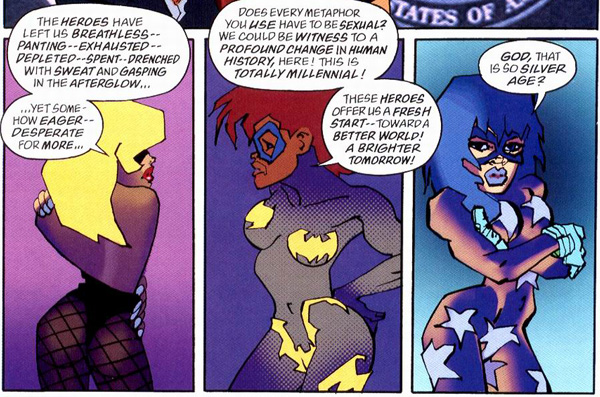
The thing about the Silver Age that a lot of people miss is that it wasn’t a new Flash or Green Lantern that made it interesting. It wasn’t Hal Jordan or Barry Allen. They were secondary to the real charm of the Silver Age. The true draw was the new ideas. It was people in costumes doing awesome things. It was like looking through a window and seeing something brand new.
This is why Silver Age nostalgia trips bug me. I don’t care about Barry Allen or Hal Jordan. They are not why I like the Flash or Green Lantern. They’re icing on the cake, but the cake is made up of “Flash Facts” and giant green supermodels catching airplanes.
MILLER: Not exactly. No. The first thing I wanted to do was to try to take a new reader and make him feel the way I did when I was about 9. With the opening with the Atom and all of that. I tried to reinterpret each of these heroes by their powers.[snip]The thing that makes these superheroes interesting is that they look really cool and they can do stuff. So what I was after, for the first third of it, was to reintroduce the idea of these powers being really cool.


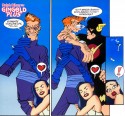
DKSA is filled with many heroes who came into their own in the Silver Age. Green Lantern is Hal Jordan, Barry Allen is the Flash, and Ollie Queen is Green Arrow. What Miller stresses, and makes it a point to show, is that these guys have powers that are amazing.
MILLER: I looked them over again. But it was mainly just… This stuff is on my hard-drive. I grew up on it.
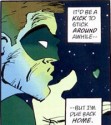 When Green Lantern comes back late in the latter third of DKSA, it isn’t with a giant green boxing glove or a jet plane with “Hal Jordan” on the side of it. It’s with a mysterious green glow of an energy field that can do what it wants, whenever it wants. It’s Hal Jordan, larger than life, godlike, blowing a giant green kiss to the Earth and professing his undying love.
When Green Lantern comes back late in the latter third of DKSA, it isn’t with a giant green boxing glove or a jet plane with “Hal Jordan” on the side of it. It’s with a mysterious green glow of an energy field that can do what it wants, whenever it wants. It’s Hal Jordan, larger than life, godlike, blowing a giant green kiss to the Earth and professing his undying love.
The Atom rides electrons and fights giant petri dish monsters. He doesn’t go from normal to small, or normal to big. He goes from giant to microscopic, but check it out– he still isn’t very tall in real life. Plastic Man is a tornado of chaos and barely humanoid. Batman doesn’t drop down off a roof and punch someone in the face. He’s barely even on-panel in the first book. He’s a mystery. He’s Ninja Zorro.

When Barry Allen is freed from captivity and Carrie “Catgirl” Kelly gives him his new outfit, he asks her why.
 “The old design was really… old.”
“The old design was really… old.”
“Kids these days,” he responds. “Can’t tell the difference between just plain old and classic.”
A split second later, Barry and Carrie are in Utah, courtesy of a superspeed getaway. They end up in Utah, and all Carrie can say is “This is so cool.”
Bringing back Hal Jordan and Barry Allen is embracing the old. Miller knows that you can’t bring back the Silver Age by digging up its bones and making it do a dance for you. Doing exciting and new things with these dusty old icons is the only way to make them interesting.
Heroes Age With Us
MILLER:Near parody is fair, because I think that it kind of slides in and out of it. I just let that happen because that’s what felt right with the story. Because I felt that, every once in a while, you’ve got to take a deep breath and realize that you’re doing something intensely silly, and then go back to the operatic. For me, it’s the juggling of the two that creates a nice kind of tension. I think that perhaps what I was reacting to most was the over-reverential tone of so many modern comics.
DKR was written because Frank Miller realized that he was older than Batman all of a sudden, and that didn’t seem right. DKSA, though, takes place a few years later, making Bats even older. It’s entirely fair to say that DKSA is a book about a bunch of geriatric heroes. There is a thriving youth movement, particularly in terms of Catgirl and Supergirl, but the big heroes? Oh yeah, they’re super-wrinkly.
 It shows all over the book. Barry Allen puts on reading glasses while checking out a magazine. Captain Marvel reveals that Billy Batson died some time back, and Marv himself looks like a grandpa. Superman and Wonder Woman are the most vibrant old folks in the book. Even Bruce Wayne is completely bald.
It shows all over the book. Barry Allen puts on reading glasses while checking out a magazine. Captain Marvel reveals that Billy Batson died some time back, and Marv himself looks like a grandpa. Superman and Wonder Woman are the most vibrant old folks in the book. Even Bruce Wayne is completely bald.
And as the heroes have aged, their values have aged, too. We don’t live in 1945/1956/1964/1971/1986 any more. Times change and rules change. You can either change with them or be broken on the rocks. Superman, Wonder Woman, and Captain Marvel enforced the status quo for too long and it came back to bite them. The world changed and, for all their power, they stagnated.
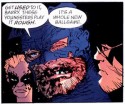 The crux of DKSA can be found in how Batman embraces the youth. He uses youth culture to spark a revolution of thought. He gets Supergirl where she needs to be to do the most damage. His most trusted person, period, is Catgirl, a former Robin. He takes the Thanagarian children under his wing and recognizes that the rules aren’t the same. If what Lex Luthor needs is a mace in the face, then he needs a mace in the face.
The crux of DKSA can be found in how Batman embraces the youth. He uses youth culture to spark a revolution of thought. He gets Supergirl where she needs to be to do the most damage. His most trusted person, period, is Catgirl, a former Robin. He takes the Thanagarian children under his wing and recognizes that the rules aren’t the same. If what Lex Luthor needs is a mace in the face, then he needs a mace in the face.
The young exist to eat the old. It will happen every time unless the old can adjust to the new world. When Superman asks his daughter what they should do with their planet, he’s finally accepted the new world that he’s been living in for decades. It doubles as both a question of authority–“This is our planet, and we control its progress”–and acceptance.
The Earth is ours, as people, as humans. We control its progress.
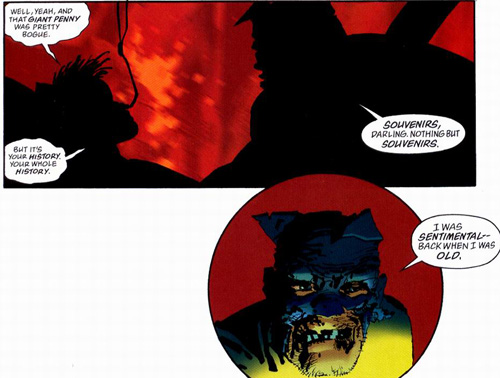
The very last exchange of the book is between Carrie and Batman. The Batcave has been destroyed and everything he had is gone. Carrie mumbles about how it’s his whole history, and Bruce shrugs it off.
“Souvenirs, darling. Nothing but souvenirs. I was sentimental– back when I was old.”
All those old comics, all those old stories that were bright and shiny thirty/forty/fifty/sixty years ago– all of those are souvenirs. They had their place, but now they are dusty. Their time has passed, and it is time for something new. New stories, new ideas, a new way of thinking. Take the toys out of the box and break them. This ain’t a museum, kid, so get outta here with that hero worship nostalgia buff business.
Grow up and learn to really love these guys in the tights. They aren’t fragile.
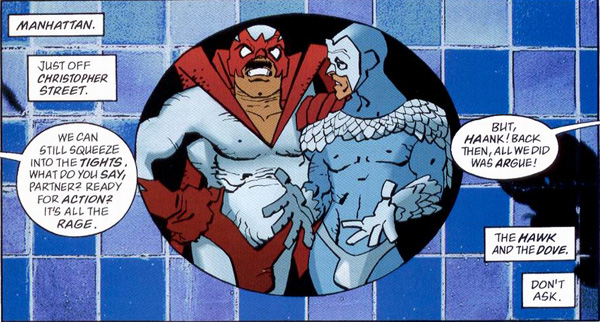
Go Out With a Lion’s Roar!
MILLER: Would you expect Amazons to be nice?
Captain Marvel doesn’t get short shrift in DKSA, exactly, but he doesn’t get a lot of panel time, either. Wonder Woman is in a similar position, though she has a more substantial role than he does. Both of them are there to play backup to Superman, but Miller turns both characters in interesting directions.
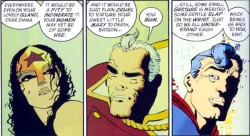
The few panels he does appear in are packed with personality. He’s even more of an adolescent fantasy than Superman is. He’s the boy who turns into, or switches places with, a superhero with a magic word. He’s Leave It To Beaver and the Brady Bunch in tone– unfailingly polite and measured, but strong. He’s a child’s idea of what an adult is like.
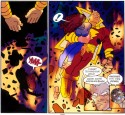 In DKSA in particular, Marv is practically quaint. When Lex Luthor threatens the loved ones of the World’s Mightiest Mortals, Wonder Woman and Superman grimace or look shocked. Marv just squints through his CC Beck-style eyes, raises an eyebrow, and says “You bum.” When he rescues a woman from an explosion and she says, “I want to have your child,” he stays respectful and polite. “Ma’am. You’re making me blush.”
In DKSA in particular, Marv is practically quaint. When Lex Luthor threatens the loved ones of the World’s Mightiest Mortals, Wonder Woman and Superman grimace or look shocked. Marv just squints through his CC Beck-style eyes, raises an eyebrow, and says “You bum.” When he rescues a woman from an explosion and she says, “I want to have your child,” he stays respectful and polite. “Ma’am. You’re making me blush.”
Captain Marvel is old, though, and Billy Batson died some time back. When it’s finally time for Marvel to die, he says that he’s going to go where a wish goes, where a dream goes when you wake up and can’t remember it. He’s going to nowhere. Wonder Woman urges him to say the word and “go out with a lion’s roar.” He shouts “Shazam!” in a compressed and tight panel, lightning strikes, and he dies.
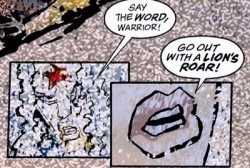
Wonder Woman’s last words to Captain Marvel sum up her character perfectly. While no one quite knows where to place her in the current DC Universe, Frank Miller has found somewhere that she shines. Batman is Zorro, the swashbuckling avenger. Superman is the ultimate hero. Wonder Woman sits at the empty end of the trinity, and she is the warrior.
Her first appearance in DKSA establishes her as the Queen of the Amazons and is quite a change from her usual appearance. Her tiara resembles an ancient Greek helmet, her eyes are thick with eyeliner, reminiscent of a greek vase, and her hair is curly. She’s Superman’s wife, and she’s a super woman.
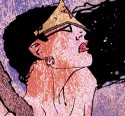



When Superman is beaten, demoralized, and completely ruined, she’s the one who gets him back on his feet. She reminds him that he is a god, a man, and Superman, and in doing so, rejuvenates him.
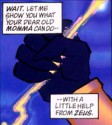 Later, Superman is falling against Brainiac. Wonder Woman steps in, riding on Pegasus, and literally brings down the lightning. When the going gets tough, Diana raids the Wonder Armory and borrows the tools of the gods.
Later, Superman is falling against Brainiac. Wonder Woman steps in, riding on Pegasus, and literally brings down the lightning. When the going gets tough, Diana raids the Wonder Armory and borrows the tools of the gods.
Captain Marvel being the Cool Grandpa and Wonder Woman being a warrior, rather than an ambassador, works for both characters. Both takes have legs, and Miller is deft enough to get a lot across in not a lot of dialogue. You know that Marv is a true hero, but you also know that he probably won’t say anything harsher than “bum.” You can easily extrapolate Wonder Woman’s role, and her youth when compared to Superman and Captain Marvel, from her on-panel time. She’s seasoned and realistic, but not mean. She knows what she needs to do to get the job done.
To Be Continued…
There’s a slight change of plans. I’d originally planned to make this Sons of DKR thing three posts long, but whoops, look at that, this post alone is something like 2.3k words. The next post will probably be comparable in size, so get your reading glasses, y’all. I have three more subjects to talk about, and they’re probably the three most important character-based bits in the book. Here’s the line-up:
-Superman: Who He Is, What He Can Do, What He Does Not Do
-Catgirl/Supergirl: Who They Are, And What They Represent
-Batman: Who He Is and How He Came To Be
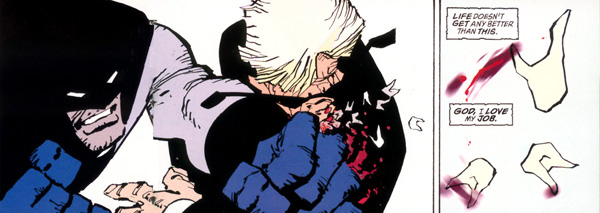
Catch you on Friday. Same Bat-time, same Bat-channel.

Good show. A couple of observations/thoughts:
“Souvenirs, darling. Nothing but souvenirs. I was sentimental– back when I was old.”
The story’s closing words really remind me of Bob Dylan’s fantastic “My Back Pages.” I find that there are actually quite a few similarities between Dylan’s song and Miller’s comic. Both deal with the letting go of old ways and outdated ideals, and a metaphorical growing younger. It’s an interesting bit of intertext.
Just take the last verse of the song and compare it to the change in philosophy and vision that DKSA suggests that heroes/people must embrace: “Yes, my guard stood hard when abstract threats / Too noble to neglect / Deceived me into thinking / I had something to protect / Good and bad, I define these terms / Quite clear, no doubt, somehow. / Ah, but I was so much older then, / I’m younger than that now.”
“All those old comics, all those old stories that were bright and shiny thirty/forty/fifty/sixty years ago– all of those are souvenirs. They had their place, but now they are dusty. Their time is past, and it is time for something new. New stories, new ideas, a new way of thinking. Take the toys out of the box and break them. This ain’t a museum, kid, so get outta here with that hero worship nostalgia buff business.”
Perhaps the depiction of Dick Grayson that appears in DKSA could also be mentioned in this context. I honestly found Grayson’s role in the comic to be rather jarring, it was probably the only thing about DKSA that I really disliked; it felt like it came out of nowhere, had relatively little to do with the wider plot, and it kinda felt like Miller was pissing on the character for no particular reason.
But now that I read your piece, it strikes me that he does fit in the whole old/young opposition (not the right word, I know, but the correct one escapes me) that is found throughout DKSA. Grayson is someone (a young man, ironically enough) who is completely caught up in the past and is unable and unwilling to let go. It is no wonder then, that he is an insane villain who meets his demise at the end of the story. Grayson is the opposite of Batman, a character who is willing to let go, move on, and grow into something better because of it.
I love DKSA. It’s vibrancy leaps off every page. It’s pure comics energy. For all it’s sloppiness (and it does derail somewhat two-thirds through) it’s an invigorating, ballsy and often lunatic comic. Varley’s colouring got so much stick at the time, yet I’d rather look at her neo-psychedelic palette than the over rendered turd-polishing ‘realism’ of your average Marvel/DC book.
I skimmed through DKR when it was first anthologized and found it a jarring mess. Now I feel the need to give it a careful read. If that was what you were going for here, mission accomplished.
@jp: I won’t lie and say that it isn’t a mess. DKSA’s flaws are so obvious that its inner gems tend to get buried under them, depressingly. The narrative makes a turn after 9/11 that may not be for the better, but definitely makes for a more interesting reading. There’s a lot to like about DKSA, and if not like, there’s a lot to examine. I think that, as a complete work, it has legs. It’s a shame it’s sitting in the shadow of nostalgia.
@The Beast Must Die: I’m torn. There are pages that Varley nails perfectly (Superman in the ruins of Metropolis, the encounter between Carrie/Grayson/Bruce at the end there), but then there are others that are just a dayglo mess. The big entry of Batman right before the end of book two is a mess.
@Derk van Santvoort: Yeah, I’m definitely talking about Grayson and Batman, in the context of Who Batman Is, on Friday. I’ve got the bulk of that bit written, but the quiet panel of “So long, boy wonder” is probably the saddest thing in the book.
Good catch on the Dylan. I haven’t heard a lot of his stuff, but that song sounds fascinating.
Yeah, I’m with jp. I did not like DKSA, at all, and hadn’t given it a second thought since it came out, but I’m really enjoying seeing you tease out what Miller at least intended to get out there.
[…] AL! David Brothers of 4thletter! shares a fond remembrance of Frank Miller’s much-maligned and underrated Dark Knight Strikes Again and drops the […]